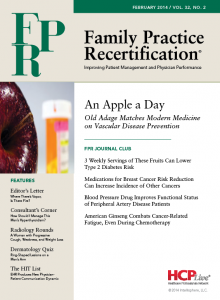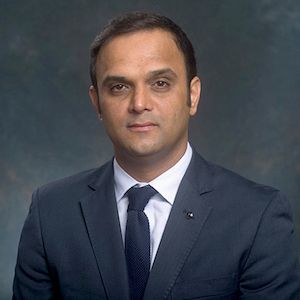Publication
Article
Family Practice Recertification
Where There's Vapor, Is There Fire?
Author(s):
Because e-cigarettes are marketed as a "safer alternative to tobacco smoking," concerns have surfaced regarding the potential for long-term health consequences that stem from inhaling vapor containing nicotine, propylene glycol, and by-products, as well as exposing bystanders to the substance second-hand.

Marin Quan, MD
Editor-in-Chief
The college campus on which my medical practice is situated has been “smoke free” since April 22, 2013. Although it took a while for all smokers on campus to get the message, by the end of that year, it was increasingly rare to find anyone smoking in a UCLA-controlled facility, regardless of whether it was an indoor or outdoor area. Suffice it to say it remains an absolute pleasure to work and breathe in an environment neither spoiled by the smell of cigarette smoke nor littered with cigarette butts and filters.
As a result, I was caught off guard while observing a 40-something female in the faculty center puffing smoke on what appeared to be a blue-tipped cigarette. Considering it my responsibility as a member of the UCLA community, I advised her of the smoking ban and politely requested that she put it out. Imagine my surprise when she responded it was I who was mistaken, as there was “nothing” for her to put out. She was “vaping,” not “smoking.”
First introduced in 2007, the electronic cigarette market has grown rapidly and picked up momentum in the past few years. Data released in September 2013 by the US Centers for Disease Control and Prevention (CDC) revealed e-cigarette use among middle school and high school students doubled between 2011 and 2012, from 4.7% of adolescents to 10%. So far, more than 1.7 million students have tried them.
E-cigarettes are cylindrical devices consisting of a battery-operated vaporization chamber and a cartridge filled with propylene glycol, glycerin, and liquid nicotine in varying strengths. With one puff, the user activates the device to heat the liquid, transforming it into a nicotine-enriched vapor that is inhaled and expelled in the same manner as a cigarette. But unlike their traditional counterparts, e-cigarettes contain no tobacco and do not call for combustion. As a result, e-cigarettes are able to deliver a similar or greater dose of nicotine without the production of harmful combustion toxins, and the tars and carbon monoxide associated with conventional smoking is neither inhaled by the user nor released into the environment as second-hand smoke.
Since e-cigarettes do not contain tobacco, they are not subject to US tobacco laws or federal oversight. But because they are marketed as a “safer alternative to tobacco smoking,” concerns have surfaced regarding the potential for long-term health consequences that stem from inhaling vapor containing nicotine, propylene glycol, and by-products, as well as exposing bystanders to the substance second-hand.
Although using an e-cigarette as a smoking cessation tool might help some smokers quit, it may simply provide a means for others to get their nicotine fix in a smoke-free area and remain nicotine-dependent with a lesser social stigma. Of greater public health concern is the potential for the product to promote and foster nicotine addiction among non-smokers, particularly young people. Furthermore, by renormalizing an act that simulates smoking, the growing acceptance of e-cigarettes could dampen or undermine the social stigmatization associated with smoking that has taken decades to achieve, and it may potentially serve as a linchpin for a new generation of smokers.
Until such a time when all medical and health behavior issues are settled, it seems only prudent to recommend the following:
- Regulating e-cigarettes as a tobacco product through the US Food and Drug Administration (FDA). Such a proposal is already under review at the White House Office of Management and Budget (OMB).
- Imposing the same advertising and marketing restrictions on e-cigarettes as those currently applied to traditional cigarettes.
- Banning the use of e-cigarettes in all designated “smoke-free” areas, including restaurants, workplaces, college campuses, and other public areas. UCLA had the foresight to include the use of unregulated nicotine products in its smoke-free policy, so I was able to advise the aforementioned woman in the faculty center that “vaping” is prohibited, as well.
- Prohibiting the sale of e-cigarettes to minors. This measure has already been taken up by many cities and states, including New York and Illinois this year.
- Strongly discouraging non-smokers from using e-cigarettes.
- Recommending the first-line use of efficacious gum, patch, or inhaler nicotine replacement devices over e-cigarettes in smokers who are trying to quit. Non-smokers are much less likely to emulate someone who uses one of the former devices, as opposed to someone who fires up an e-cigarette.
- Relegating the use of e-cigarettes to smokers attempting to quit who are recalcitrant to behavioral, pharmacologic, and nicotine replacement strategies, at least until e-cigarettes are proven to be as effective as other nicotine replacement devices.
As the famed Spanish-born philosopher George Santayana once said, “Those who can remember the past are condemned to repeat it.” We continue to pay the price for permitting this to happen with tobacco products, so let’s not allow it to be the case for e-cigarettes.
Martin Quan, MD
Editor-in-Chief
Martin Quan, MD, is Professor of Clinical Family Medicine and Director of the Office of Continuing Medical Education at the David Geffen School of Medicine at UCLA. He is also a member of the Education Advisory Board and consultant to the Committee on Continued Professional Development of the California Academy of Family Physicians and a member of the Kidney Learning System Advisory Board of the National Kidney Foundation. In the past, Quan has served as Program Director of the UCLA Family Practice Residency Program, Co-Director of the UCLA Pre-Doctoral Program in Family Practice, Editor-in-Chief of Clinical Cornerstone, and Vice Chair of the Residency Review Committee in Family Practice for the Accreditation Council for Graduate Medical Education (ACGME).





